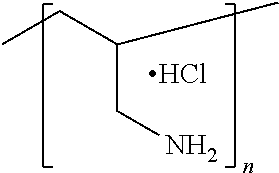Hair treatment method and kit thereof
a hair and hair technology, applied in the field of hair treatment methods, can solve the problems of irritating the scalp of users, damage to the structure of hair, and undesirable odour of the hair used,
- Summary
- Abstract
- Description
- Claims
- Application Information
AI Technical Summary
Benefits of technology
Problems solved by technology
Method used
Image
Examples
examples
[0357]The following are non-limiting examples of the method of the present invention. The examples are given solely for the purpose of illustration and are not to be construed as limitations of the present invention, as many variations thereof are possible without departing from the spirit and scope of the invention, which would be recognized by one of ordinary skill in the art.
Hair Treatment with “White Pigment” and “LbL (Layer-by-Layer)”
[0358]In general, hair swatches were treated with “LbL Solution” and “White Pigment” to create a bright (whitish) surface on the hair. The hair swatches were provided from Kerling International Haarfabrik GmbH, Backnang, Germany. The “White Pigment” was provided from Merck KGaA, Darmstadt, Germany. The “White Pigment” had the following L*a*b* values, measured by using a Minolta spectrometer as described hereinbefore: L*: 78.08; a*:1.24; b*: 3.88. The “White Pigment” had a D50 particle diameter of 1 μm measured with a Malvern Mastersizer 2000 as des...
PUM
| Property | Measurement | Unit |
|---|---|---|
| Time | aaaaa | aaaaa |
| Zeta potential | aaaaa | aaaaa |
| Fraction | aaaaa | aaaaa |
Abstract
Description
Claims
Application Information
 Login to View More
Login to View More - R&D
- Intellectual Property
- Life Sciences
- Materials
- Tech Scout
- Unparalleled Data Quality
- Higher Quality Content
- 60% Fewer Hallucinations
Browse by: Latest US Patents, China's latest patents, Technical Efficacy Thesaurus, Application Domain, Technology Topic, Popular Technical Reports.
© 2025 PatSnap. All rights reserved.Legal|Privacy policy|Modern Slavery Act Transparency Statement|Sitemap|About US| Contact US: help@patsnap.com



